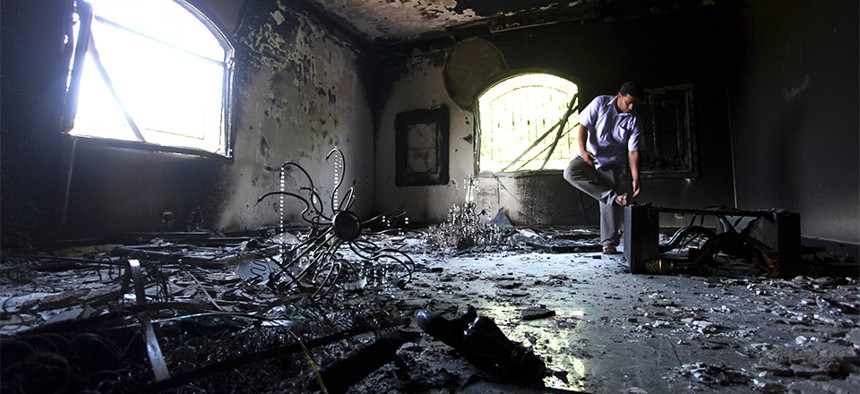
Mohammad Hannon/AP
Stopping the Next Benghazi Through Technology
The State Department’s security bureau seeks everything from systems to track diplomats’ location to portable firearms training tools. By Joseph Marks
Since the terrorist attacks on American diplomats in Benghazi, Libya last year, official Washington has been obsessed with figuring out how it happened and who should shoulder the blame. Meanwhile, the State Department bureau charged with protecting U.S. embassies and consulates is trying to prevent the next such attack. And its leaders clearly think technology can provide at least part of the answer.
Last month, State’s Diplomatic Security Bureau issued broad “sources sought” notices seeking a system that can identify what type of small arms are being fired at an embassy and where the shots are coming from; a portable firearms training tool that can mimic firing everything from a Glock 19 pistol to an M870 shotgun; and upgrades to a physical security information management system that collects and monitors video and sensor data from embassies worldwide.
The same week those notices went out, State awarded Virginia-based Blackbird Technologies a $15 million contract for a system to track diplomats’ location inside embassies using their cellphone signals.
The bureau’s technology buying decisions aren’t just based on Benghazi, but on the history of attacks stretching back to the 1998 bombings at U.S. embassies in Africa and the 1979 seizure of the U.S. embassy in Tehran, said a diplomatic security official who asked not to be named.
The agency must assess the role of new technology on an embassy by embassy basis, the official said. In places without reliable Internet connections or where electronics could easily be damaged by intense heat or cold, it would be a mistake to rely too heavily on advanced technology.
“We’re looking toward the future and making sure we stay ahead of terrorists,” said Wayne Ashbery, director of the bureau’s Office of Security Technology. “We’re deploying systems that will be ready for the next attack, not just the last one.”
Ashbery manages a staff of roughly 1,000 State Department employees and contractors focused on the technological side of embassy security and the safety of diplomats abroad. The sources sought notices they have issued don’t obligate the government to purchase any new technology. Sometimes, the notices are issued with a particular new acquisition in mind. Other times, officials are simply surveying the state of technology in a particular field.
The diplomatic security bureau also has invested in new training in recent months and put more than $1 billion toward new embassy construction projects focused on improving security.
“We always try to strike a balance between the different aspects of security -- physical security, technological security and the human element,” Ashbery said. “We have multiple layers of security rather than a single layer.”
The small arms detection system the bureau is seeking would provide an audio and visual warning of an embassy attack and note the location of the shooter, according to the sources sought notice. It also would classify the type of weapon being fired -- such as a gun, rocket or rocket-propelled grenade -- and collect forensic information about the number of rounds fired for after-action reports.
The physical security information system must be able to aggregate and analyze data from multiple security systems, including access control systems and digital video recordings, according to documents. It must display data in numerous formats, including three-dimensional models, and must be compatible with Google Earth, the notice said.
“The evolution of technology is exciting for us,” Ashbery said. “It gives us the opportunity to employ systems we could have only imagined previously. Several decades ago the ability to interconnect all the embassy camera systems simply wasn’t possible.”
Technology also is developing so rapidly that State’s priorities for embassy protection can change dramatically from one budget cycle to the next.
“One thing I’m certain of,” Ashbery said, “is that in the next five or 10 years, with the rate of technology advancement in the industry, the shape of our security systems will be very different from what they are now.”




